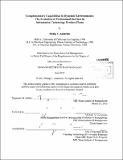Complementary capabilities in dynamic environments : the evolution of professional services in information technology product firms
Author(s)
Anderson, Phillip C., Ph. D. Massachusetts Institute of Technology
DownloadFull printable version (19.46Mb)
Alternative title
Evolution of professional services in information technology product firms
Other Contributors
Sloan School of Management.
Advisor
Michael A. Cusumano.
Terms of use
Metadata
Show full item recordAbstract
The innovative firm must continually evaluate its boundaries - decisions often shaped through make-buy-partner evaluations and choices about where to define the firm's competences. Building off of earlier work that suggests heterogeneity in types of organizational competences, I submit that a firm's portfolio of organizational capabilities map across three states: core, supplementary, and complementary. Core capabilities are the defining competences that are imprinted during the founding and formative years of the firm. Persistence in the core often leads to inaction and failure. Supplementary capabilities may form after the firm establishes its core and whose origins are traced to diversification expansion events. Complementary capabilities may form at founding and/or as managers detect competence gaps during changing conditions. Complementary is activated primarily to increase the value of the core. Given the firm as a portfolio of heterogeneous competences, the dissertation's focus is on when, why, and how the established innovator activates new complementary capabilities in dynamic environments. The context is hardware product vendors within the Information Technology (IT) industry and the complementary organizational capability is the business of professional services - e.g., consulting, systems integration, and custom implementation. Considering the expansion into professional services as a type of related diversification, the first paper uses panel data of U.S.-based IT product firms from 1987-2008 to explore the industry-level patterns behind the expansion into complementary services-centric domains given the core expertise in R&D-centric activities. I find that product firms who were diversified into more complementary R&D-centric activities (e.g., software) were more likely to diversify into complementary professional services - suggesting that professional services are part of a larger architectural/portfolio enablement strategy. The next part of the dissertation explores this phenomenon further by examining the process by which two innovative firms activate new complementary capabilities using polar-opposite dominant models: EMC preferred to "make" while Cisco preferred to "partner." Both case studies emphasize the process and unique dilemmas with the activation and evolution of complementary capabilities from 1995-2010, an era marked by continuous technological change and market uncertainties. I conclude with a discussion of the common patterns across these two firms and managerial implications.
Description
Thesis (Ph. D.)--Massachusetts Institute of Technology, Sloan School of Management, 2012. Cataloged from PDF version of thesis. Includes bibliographical references (p. 253-262).
Date issued
2012Department
Sloan School of ManagementPublisher
Massachusetts Institute of Technology
Keywords
Sloan School of Management.